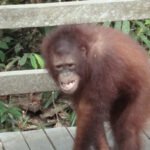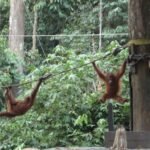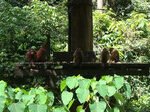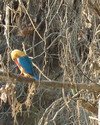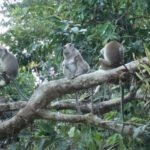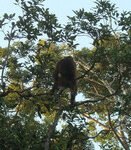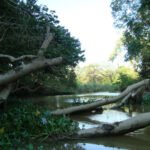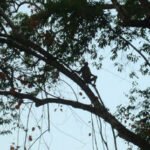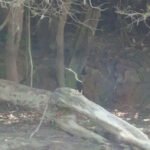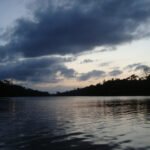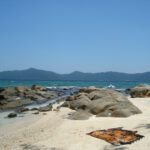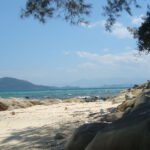Two Backpacks

Chapter 24 - Orangutans & Kinabatangan River, Sabah
We’re off to see the orangutans at the Sepilok Rehabilitation Centre on Sabah.
Kuala Lumpur has become our jumping-off point for many of our trips over the year. After another night at Air Asia’s Tune Hotel, a stone’s throw from their Kuala Lumpur departure lounge, we’re up early for our flight to Sandakan.
We booked our flights six months earlier when Air Asia launched with special promotions to numerous destinations; our tickets cost us nothing; all we paid were the taxes at around twenty-five dollars each.
Our early morning flight is on time and hassle-free. In the arrival hall, we retrieve our backpacks and then go outside to join the taxi queue. When the next free taxi pulls up alongside us, the driver gives us a huge welcoming smile and helps Ron stow our packs into the boot of his car.
‘Where to?’ he asks as we settle into our seats.
I’m so relieved he speaks English. ‘Sandikan,’ I reply. ‘But we haven’t booked a hotel. Do you know one that’s not too expensive?’
‘I can help you find nice hotel,’ replies our happy driver.
Ten minutes into our trip, the road turns towards the ocean and continues along the coastline.
‘Look, Ron! A floating village!’ I exclaim as we pass a higgledy-piggledy assortment of rusting tin roofs and wooden slatted buildings.
‘Danger! Only go with tour,’ comments our taxi driver.
Sandakan is a far cry from Malacca with its quaint streets, Chinese shop houses and historic buildings. We manoeuvre through crowded streets towards the city centre; laundry hangs from lines crisscrossing the streets, strung between the buildings like thousands of flags fluttering overhead.
The first two hotels we try are both full. I’m beginning to wish we’d not come.
‘Let’s try one more,’ suggests our taxi driver as we set off again.
Five minutes later, we pull up outside a three-storey terraced house on a quiet street.
‘Try here,’ instructs our driver.
The hotel owner confirms he has a vacant room, and it’s within our budget. I return to Ron, waiting in the taxi and give him the good news.
‘Thanks for helping us. I don’t know what we’d have done if you hadn’t found us a room.’ Ron says, paying the driver and giving him a generous tip.
Our hotel, in the centre of town, is an oasis – clean, modern and comfortable. Tired from our long day, we decide on an early supper.
Walking through the area close to the hotel, we’re dismayed to find very few eateries.
‘Let’s try and find the beach,’ suggests Ron before adding, ‘This place doesn’t feel safe. It’s like being back in Glasgow, constantly having to watch your back. It’s just a feeling I’ve got. Don’t go wandering off, Sandi.’
I don’t feel unsafe, but Ron’s obviously worried, so I do as he asks and stick close to his side as we walk down a narrow street leading to the shoreline.
The sun’s setting as we choose one of only three cafes open. The menu is basic. We both chose the safest option, nasi goreng (fried rice).
‘I know you want to explore, but I don’t think it’s safe. Best we get back to the hotel before it’s dark,’ suggests Ron once he’s finished his meal.
Our walk back is quick; there’s no dawdling, no time to window shop or explore. Ron’s nervousness has made me jittery too. I hold his hand as we walk back through the streets. Ron’s concern has heightened my senses. I’m more aware of who’s behind us and what’s happening around us.
‘I’ll be glad when we’re out of here,’ mutters Ron as we return to our hotel.
**********
I’ve done my research and know the Sepilok Orangutan Centre has a ten o’clock morning feeding time for the primates.
‘Come on, Ron. Get a move on. We can’t miss the bus!’ It’s half past eight, and Ron’s fiddling around, packing his computer away. We only just make it to the bus in time.
At the Centre, we pay our entrance fee and follow the signs into the jungle. Around us, birds call from high in the leafy, green overhead branches. There’s a rustle in the undergrowth near our well-trodden dirt path. I turn, but I can’t see anything in the dense vegetation.
Dappled sunlight dances through the verdant overhead canopy of trees as we make our way deeper into the jungle to the feeding station. It’s so peaceful.
‘I feel I have to whisper so as not to disturb the life here,’ I say to Ron sotto voce.
The jungle path ends at the viewing area. A crowd has already gathered.
I see two wooden platforms with rope swings and zip lines between the trees. There’s a murmur in the crowd as one of the wardens approaches and deposits the contents of a giant bin of fruit onto the platforms.
We wait in anticipation, scouring the trees for the first sign of an orangutan.
A flying squirrel, or perhaps a flying fox, soars above us. Then, two Macau monkeys arrive, followed by some playful youngsters, four sedate females, and a small group of larger, more aggressive, full-grown males. The young Macau monkeys cavort around us, happy to sit on the rail of the viewing platform as if posing for photographs.
Then, as if on cue, two young orangutans swing into view. Hand over hand, the long-haired, bronze-coloured primates clamber along the rope to one of the feeding platforms.
We watch as they rummage through the assortment of fruit and, having found a piece of fruit to their liking, munch away, oblivious to the crowd watching them. They frolic on the rope swings. One decides to investigate the strange humans nearby and swings through the branches to our observation platform. Camera shutters click in unison.
The youngster bares its teeth, perhaps smiling for its audience and then clambers onto the wooden fencing, where it sits for a few moments. Then with a screech, the youngster rushes back to its companion, and they both disappear into the dense foliage once more.
We all wait patiently for the arrival of more orangutans but are disappointed. We learn later that there is another feeding station deeper in the jungle where older, more mature animals feed.
There are over one hundred rescued animals in the Sepilok reserve. Its aim is for the animals to fend for themselves; the fact that they don’t come for bananas every day proves the scheme is working.
As we get ready to leave, I notice two more visitors arrive. I’m convinced I’ve seen the woman before.
‘Ron, do you recognise the woman over there?’
Ron glances in her direction and laughs.
‘It’s the woman we were with on the Great Wall trek! You know, the one who couldn’t believe we’d made it to the finish before her! What are the chances of bumping into someone we met nine months ago?’
We spend a few minutes catching up on each other’s travels before we catch the bus back to Sandakan.
‘I wonder where we’ll bump into her next time?’ comments Ron as our bus lurches along the dusty dirt road.
*********
We’ve booked a half-day trip on the Kinabatangan River, leaving from Sukau, a two-hour drive from our hotel. When I’d suggested the trip, Ron hadn’t been keen.
‘You’ve seen the orangutans, been to the jungle. Why do you want to go on another trip to see trees?’ he’d argued.
‘I thought an afternoon on the river would be a great way to finish our trip to Borneo,’ I’d retorted. ‘But it’s up to you. If you don’t want to take the trip, I’ll go on my own.’
Ron had given in, more from worry about me than a need to see more animals and jungle.
Hardin, our tour guide, meets us at our hotel at midday and promises sightings of various birds and animals.
Ron’s sceptical. ‘Think we’ll be lucky if we see a few monkeys!’ he grumbles as he clambers into the four-wheeled drive. Ron wasn’t keen on the trip. We’re about to set off, and his mood isn’t great.
On arrival at the small village of Sukau, Hardin leads us to a flat-bottomed boat. At two o’clock in the afternoon, it’s hot and humid.
‘I’m not sure setting off at this time of day is a good idea,’ I whisper to Ron as I tug my sun hat onto my head, and we settle onto the two ‘guest’ seats in the boat’s bow.
‘Nothing we can do now. Just hope he stays to the shaded side of the river,’ adds Ron, whose mood grows darker with each passing hour.
The trip starts well with sightings of kingfishers, young crocodiles and cormorants, plus swifts nesting in the rock face crevices along the river bank. But as the day progresses and the heat intensifies, sightings become fewer.
‘None of the animals are stupid enough to be out in this heat!’ mutters Ron.
Our guide steers the boat as close to the bank as possible, seeking shade from the overhanging trees. At one point, the engine revs ease. Hardin points to a spot directly above us.
There, hanging lifeless in the humid afternoon heat is an enormous snake, its body as thick as a man’s arm twisted around the overhanging branch.
I clutch Ron’s hand. I hate snakes! And this one is hanging right above me!
My throat is dry; my heart is racing. ‘Get us out of here,’ I gasp to Hardin, who smiles and guns the engine again.
Now I’m on the alert. Whenever we head for the overhanging trees, I search the branches for snakes!
Three hours into our trip, the sun begins to dip below the jungle skyline. As the evening breeze strengthens and the air cools, we begin to see more birds and a few monkeys but no orangutans, although Hardin does point out a few orangutan nests high up in the trees.
With the skies darkening and wildlife difficult to spot, we turn for Sukau and home.
‘Haven’t seen much in the way of wildlife, have we?’ comments Ron turning to our guide.
‘Ron! We’re in a boat, in the heart of the jungle! Don’t antagonise our guide,’ I whisper, hoping Ron’s Scottish accent has meant Hardin hasn’t grasped what he’s said.
Unfortunately, Hardin has understood every word. He pulls on the boat’s rudder and steers towards a small estuary. ‘You’ll see wildlife, I promise,’ he states, glaring back at Ron as he carefully navigates along the narrow waterway.
Suddenly, the air is filled with yells and screams high up in the trees around us. It’s a group of Macaque monkeys. Hardin slows the boat. ‘The noise is from the larger males. They’re guarding their females and territory,’ he explains, pointing to two males fighting in the treetops.
A little further, the engine slows again. ‘You hear that call?’ asks Hardin.
Both Ron and I nod.
‘Silver monkey,’ advises our guide, scanning the nearby trees for a sign of the elusive animal.
Ten minutes later and with no silver monkey in sight, we’re on our way back along the small river when we see a proboscis monkey, its silhouette against the skyline looking more like a man with a large nose than a monkey.
Others appear a few seconds later, followed shortly after by a loud screech as one male, intent on protecting his area, flies through the trees, leaping between the branches, frightening off the intruding monkey.
As dusk gives way to the night sky, we pull up alongside the village jetty. It’s half past eight when we finally arrive back at our hotel.
‘It was an interesting river trip, but I wish we’d seen orangutans and elephants,’ I say as I head for the shower.
‘I suppose,’ comments Ron, unenthusiastically. ‘Me, I’d give anything to see a nice cold beer right now!’
**********
We leave our hotel in Sandakan early the following morning and travel overland to Kota Kinabalu. The long, six-hour bus journey is tiring but worthwhile as our route takes us through beautiful mountains and around the base of Mount Kinabalu.
Our hostel for the night, Lavender Lodge, is comfortable, and the staff are friendly.
After a good night’s sleep, we decide to visit Mamutik Island, a chance to relax on the beach and snorkel in the waters that surround the island.
However, when we arrive at Jesselton Point, we are heartbroken to see the area awash with plastic bottles, bags, polystyrene boxes, cups, and other detritus.
‘You can’t see the water for all the rubbish,’ I cry as we walk along the jetty towards the small boat that will take us to the island. ‘It’s criminal!’
I’m near to tears. Frustration and helplessness overwhelm me as I watch another local throw a used plastic bag into the sea.
‘Come on, let’s get going. There’s nothing you can do about it today,’ urges Ron as we clamber onto our speedboat.
Mamutik Island, a ten-minute ride from Kota Kinabalu, is idyllic, with white sandy beaches, rocky outcrops, great snorkelling and very little in the way of the debris we’d seen on the mainland.
We spend the day wandering the shores, snoozing in the shade of trees that edge the beach and cooling off in the wonderfully clear, blue waters.
**********
The following day we fly to Singapore. Over the last few days, we’d read that there have been cancellations and delays with long-haul flights. So, on arrival at the airport, we make our way to the British Airways desk to check on the status of our flight to Heathrow.
Relieved that it’s on time, we check our bags and clear customs. We find two comfortable chairs in the departure lounge – Singapore Airport has sunbed-style loungers – and wait for our flight to be called.
Three hours later, we’re flying over Singapore; it feels like we’re finally on our way home.
It’s two years since I’ve been back to England; for Ron, it’s ten years since he was last in Scotland. So much has changed for us both in that time. But it’s exciting to go back to see our families and introduce each other to our loved ones.
‘I know I’m being silly, but I’m nervous about you meeting Claire and the family,’ I whisper to Ron once our supper trays are cleared away and the lights dimmed.
‘Why? You know everyone gets on with me!’ replies Ron with a smile. ‘It’ll be fine. We’ll have a great time while we’re back.’
After fourteen hours in the air, we begin our descent over London and touch down in the rain. Oh, how wonderful to be back in grey, wet, cold England!
